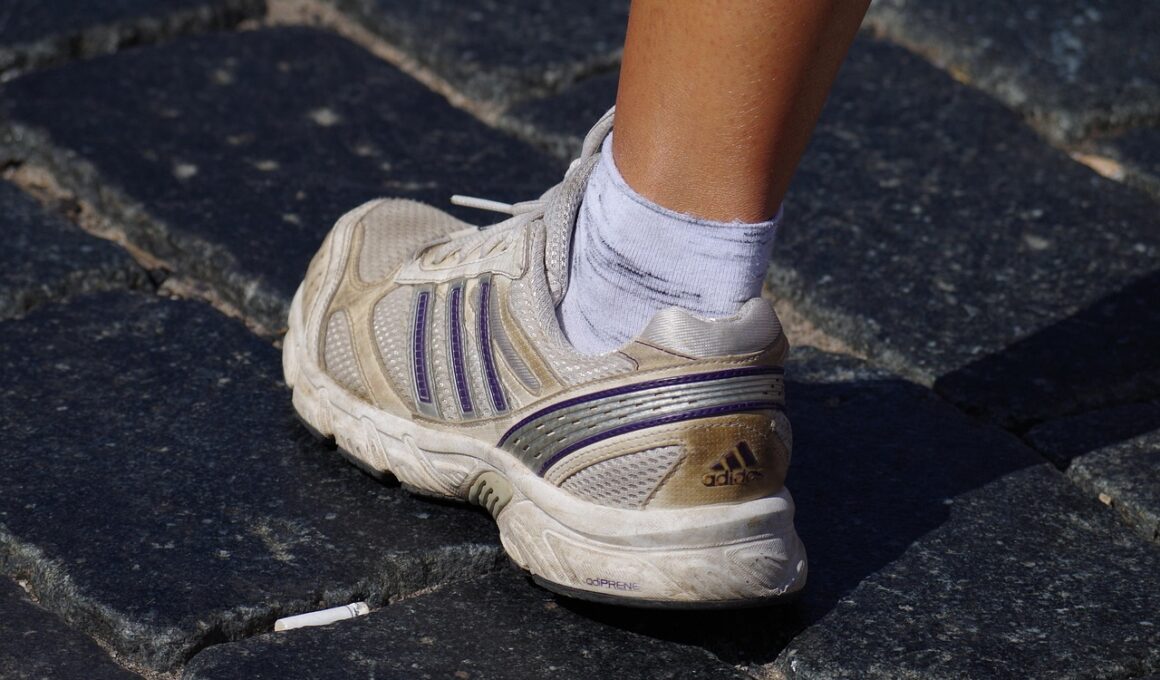Foot Pressure Measurement Techniques in Sports Biomechanics
Foot pressure measurement techniques are essential tools in sports biomechanics, enabling comprehensive analysis of athletic performance. These techniques provide insights into how athletes interact with the ground, showcasing pressure distributions that can impact efficiency and injury risk. Various methods exist, including in-shoe pressure analysis, force plates, and pressure-sensitive mats. The data derived from these methods can inform coaching strategies, help in rehabilitation, and assist in the design of footwear. For instance, pressure sensors placed in shoes capture real-time data during training sessions, providing immediate feedback for adjustments. Force plates measure ground reaction forces, focusing on vertical and horizontal components during activities such as jumping and sprinting. Meanwhile, pressure mats offer a more comprehensive view, allowing for analysis over larger areas, making them ideal for gait analysis. These techniques underline the importance of biomechanics in the improvement of athletic performance and injury prevention. As technology evolves, we can expect advancements in pressure measurement technologies that will enhance the precision and applicability of these techniques across various sports disciplines, ultimately leading to better performance outcomes and reduced injury rates.
In-shoe pressure measurement systems are increasingly used for their accuracy and ease in assessing foot dynamics during sports activities. These systems utilize thin and flexible sensor films strategically placed within footwear to monitor real-time pressure distribution. Athletes can wear the shoes during practice, competitions, or rehabilitation, providing crucial data without altering their performance. The primary advantage is that these systems can capture data dynamically, reflecting actual foot contact with the surface under specific conditions. By analyzing the collected data, coaches and sports scientists gain insights into an athlete’s gait, balance, and weight transfer. Such metrics are valuable for individualized training programs. Understanding where excessive pressure occurs can lead to the development of targeted interventions to mitigate injury risks. Additionally, this data plays a role in improving footwear design, allowing manufacturers to create better products tailored to athletes’ unique foot shapes and pressures experienced during activities. The combination of biomechanics and technology through in-shoe pressure sensors signifies a vital advancement in sports performance analysis, leading to optimized training and enhanced outcomes while reducing the potential for injuries.
Force Plates in Biomechanical Analysis
Force plates represent another significant advancement in biomechanics, particularly concerning the measurement of foot pressure. These sturdy platforms assess ground reaction forces generated during various sporting movements. Athletes perform actions such as jumping, running, or sprinting while standing on these plates, allowing researchers to gather comprehensive data on vertical forces, lateral stability, and overall balance. The analytics from force plate measurements enable coaches to understand performance nuances and identify areas for improvement. By focusing on parameters like force application rates and loading rates, coaches can adjust training routines accordingly. This information is instrumental in designing effective training programs that not only enhance performance but also focus on injury prevention strategies. For instance, an understanding of an athlete’s landing mechanics derived from force plate data can inform plyometric training adjustments to avoid common injuries like ACL tears. Force plates offer more than just numerical data; they provide a visual understanding of motion dynamics, which is crucial for optimizing athletic performance. In the realm of biomechanics, employing force plates renders a deeper comprehension of athletes’ interactions with their environment, influencing all aspects of their performance.
Pressure-sensitive mats are increasingly employed for biomechanical evaluations due to their versatility and accessibility. Unlike stationary force plates, these mats can be used on a variety of surfaces and terrains, making them ideal for outdoor and indoor assessments alike. They work by detecting and recording foot pressure across their surface during activities such as walking, jogging, or sprinting. This comprehensive pressure mapping helps in diagnosing foot imbalances and provides visual feedback essential for coaching. Sports scientists can analyze gait patterns, stride length, and foot placement, forming part of a comprehensive assessment of an athlete’s performance. When athletes utilize these mats during training or rehabilitation, it allows for real-time data collection, enabling immediate adjustments. Additionally, pressure mats lend themselves well to use in clinical settings, assisting with rehabilitation protocols. It also assists sports footwear designers by providing tangible data on performance, affecting cushioning and stability designs based on actual pressure profiles. The practicality alongside the data acquisition capabilities of pressure-sensitive mats represents a valuable blend of technology and biomechanics in sports.
Significance in Injury Prevention
Foot pressure measurement techniques play a crucial role in injury prevention within sports biomechanics. Injuries often result from improper biomechanics resulting from poor pressure distribution across the foot during activities. By utilizing these measurement techniques, sports professionals can identify critical overload areas, which are predisposed to injuries. With this understanding, tailored training interventions can be implemented to address weaknesses. For example, through pressure mapping, it becomes evident if an athlete is overly pronating, leading to strategic strengthening exercises targeting specific muscle groups. The data serves as a guide to keep athletes balanced in their approach, avoiding potential areas of risk through informed training activities. Furthermore, these techniques can be integrated into rehabilitation programs, monitoring progress and adjusting routines based on changing foot dynamics. This detailed analysis enables professionals to provide targeted feedback to athletes, helping them achieve optimal performance levels while minimizing the risk of injury recurrence. Thus, implementing foot pressure measurements integrates essential insights into injury management and prevention strategies, highlighting their significance in sports biomechanics.
Feedback from pressure measurement techniques also leads to improved footwear design, crucial for optimizing an athlete’s performance and further minimizing injury risks. By analyzing pressure profiles, manufacturers can better understand the specific needs of different sports and athletes. Custom-designed shoes can provide adequate support, cushioning, and stability based on empirical data collected from a variety of athletes in action. With advancements in technology, athletes can also benefit from personalized shoes developed through data on individual running styles, foot shapes, and pressure patterns. This approach leads to footwear that enhances performance by aligning with the athlete’s unique biomechanics rather than applying a one-size-fits-all design. Enhanced footwear contributes not only to improved performance but also comfort and confidence, vital for athletes at all levels. Pressure measurement insights lead to the innovation of concepts like adaptive cushioning, changing support throughout different activities. This progression showcases how biomechanics is not limited to the human body but extends into the technology that supports it, merging science with practical application to foster higher levels of athletic achievement.
Conclusion on Foot Pressure Measurement
In conclusion, foot pressure measurement techniques are transformative within the sphere of sports biomechanics. They open new avenues for performance analysis and injury prevention strategies through innovative approaches. As these methods evolve, they continually provide athletes, coaches, and sports scientists with invaluable data critical in shaping training regimens and footwear design. The integration of in-shoe sensors, force plates, and pressure mats allows for a comprehensive understanding of the various pressures that athletes encounter during sports activities. Such insights lead to finely tuned interventions that cater to individual athletes’ needs, enhancing their overall performance. The continuous research and advancements in measurement technologies signify a commitment to improving athletic performance while reducing injury rates. The application of these techniques will remain significant as the sports industry continuously seeks ways to push the boundaries of physical capabilities. Future developments will likely integrate machine learning and artificial intelligence, leading to sophisticated analyses that could further personalize athlete training. Overall, embracing these technologies highlights the vital interplay between biomechanics and modern sports science.
Furthermore, the growing emphasis on data analytics will enhance the understanding of athlete’s biomechanics, shaping personalized interventions. This data-driven approach fosters a culture of precise training, where each athlete’s unique pressure profiles dictate individualized strategies. As knowledge about the intricacies of foot dynamics develops, so will the approaches to injury prevention and performance enhancement. Collaboration between biomechanists, coaches, and sports medicine professionals will drive innovations across the field. With the advent of such technologies, we envision a more holistic perspective on athlete development that balances performance aspirations with sustainable health practices. Ultimately, the evolution of foot pressure measurement techniques is poised to continually shape the future of sports, effectively merging empirical analysis with practical performance improvement. This dichotomy between science and athleticism will offer a brighter future in sports for athletes and coaches alike.


